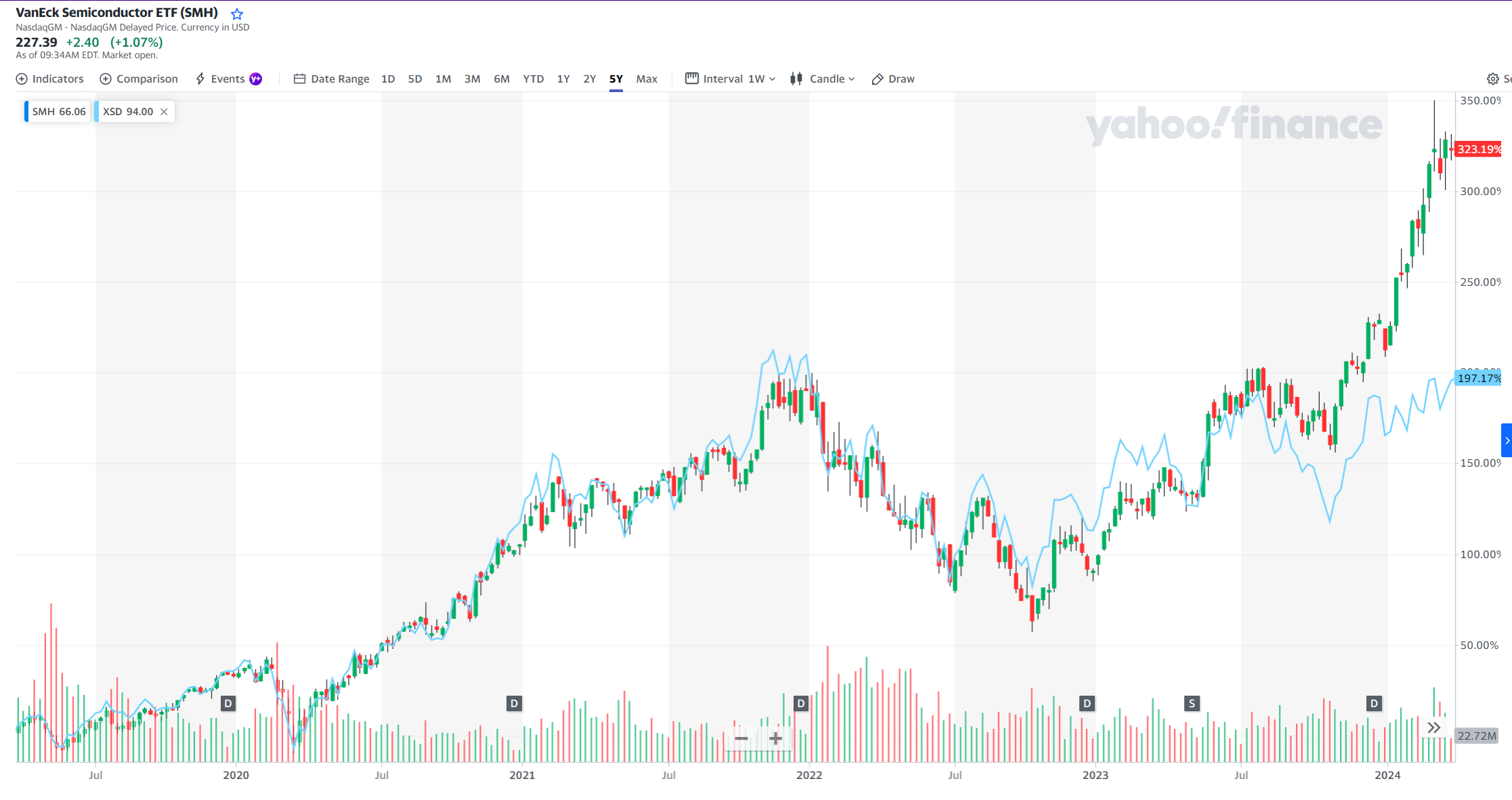Is NVDA Stock Fueling a Semiconductor Bubble


NVDA stock drives the semiconductor conversation, and a picture is worth a thousand words, so let’s start with one. With recent hype surrounding the company, understanding its performance is more crucial than ever.
Pictured below is the price history of two ETFs – VanEck Semiconductor ETF (SMH) and S&P SPDR Semiconductor ETF (XSD)
Source: yahoo finance
SMH ETF (red and green candles) is up 323%, and XSD ETF (blue line) is up 197% over 5 years. Let’s ensure our readers view the graph correctly – over 5 years from 2019 to 2024, SMH ETF is up 323% while XSD ETF is up 197%. We have only pictured the last 5 years of price history to make the comparison more accessible, but since their inception in 2000 for SMH and 2006 for XSD, those ETFs have been tracking each other pretty well. That is until 2023; since then, SMH has outperformed XSD by a large margin. Why is that? The answer is quite simple – it has to do with the holdings of each ETF.
Divergence in Performance: The Role of Holdings
SMH’s top 3 holdings include NVDA 20.55%, TSM 11.85% and AVGO 7.70%. And what about XSD? XSD seeks to keep its holdings in a “modified equal weight portfolio.” As such, the top 3 holdings of the ETF are MU 3.35%, SMTC 3.25%, and SGH 3.10%, not precisely stocks that have been in the news much. As such, the strategy of XSD would produce better results when all stocks in the sector trade at similar valuations and face identical prospects.
However, SMH shines when divergence occurs, and one or a few stocks face a much brighter future. This has never happened until 2023. What exactly happened in 2023? One might ask, AI or Artificial Intelligence is what happened. It seems like one stock in the sector – NVDA stock is expected to benefit mightily.
NVDA Stock Dominance and Growth Prospects
To put the valuations in context, NVDA stock is trading at a 75 PE Ratio (trailing 12-month PE). What about SMH and XSD? According to their issuers, VanEck and State Street, respectively, SMH is trading at a 38.80 PE Ratio while XSD is at 29.80. We want to provide another statistic: while analysts expect NVDA to grow at 30% per annum for the next 3-5 years, the XSD’s exact expectations are only 11,20% per annum growth. To put that in context, SPY ETF is expected to grow 13.80% for the period while its PE ratio is only 26.
You read that correctly – XSD is trading at a 10% premium in PE ratio relative to SPY, while its expected earnings for the next 3-5 years are expected to grow 20% slower than those of SPY. That looks strange – while AI could change the world, most semiconductor stocks are not likely to benefit from that growth, at least not in the foreseeable future.
Why would investors then buy stocks in a growth sector that are not expected to benefit from that growth?
We are not sure, but this pattern repeats itself over time. Investors who missed the opportunity to buy “IT” stocks due to high volatility or high valuation tend to buy “on the cheap” from their competitors. Sometimes, this is justified as “value investing”; the story that is usually told is, “If NVDA trades at X, why wouldn’t INTC trade at Y?”.
However naïve that logic may seem on the surface, it has actually worked reasonably well in the past because usually all stocks in a growth sector tend to benefit from that growth. Unfortunately, past performances are not indicative of future returns.
Key Takeaways
While both NVDA and INTC are semiconductor stocks nobody expects INTC to grow anywhere close to the levels of NVDA.
We are not certain that the story of NVDA stock future growth will play out as analysts or investors expect but what we are reasonably sure is that investors that buy the stocks in the semiconductor sector outside of NVDA and TSM might be disappointed. At the very least, the present odds are not in their favor.
Get the trading edge you need in today’s markets – sign up for our monthly newsletter featuring in-depth expert analysis, hot market insights, and exclusive trading strategies.

